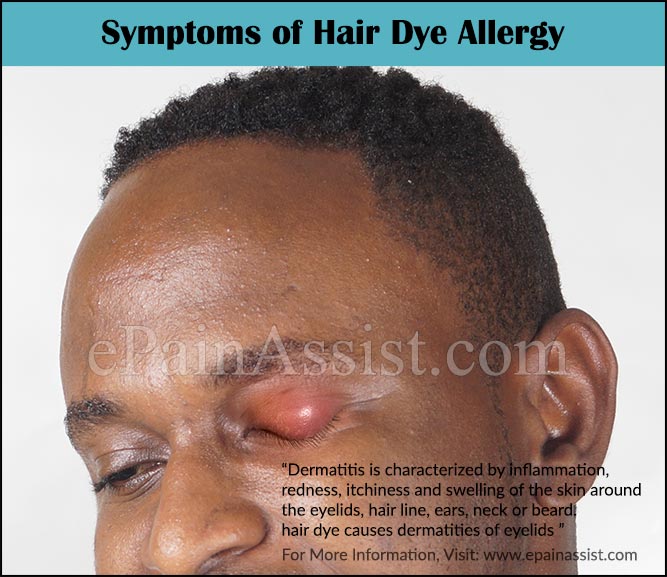Many people use hair color or hair dye to color their hair. Sometimes they color their hair just for fun or just because they are bored of their original hair color; whereas some people color their hair to cover up the grays. But hair coloring is not all fun as it seems to be, it can be quite a daunting or a nightmarish experience for some, as there is a small percentage of people who can develop an allergic reaction to the hair dye product. Most of the commercially produced hair dyes, especially the permanent kind, contain Paraphenylenediamine (PPD) along with peroxide. When these two ingredients react, there is partial oxidization and coloration of the PPD and this state of PPD results in an allergic reaction.

Symptoms of Hair Dye Allergy
Hair dye allergy produces different reactions or conditions in the body including:
Hair Dye Allergy Causing Symptoms of Dermatitis
Dermatitis is the commonest symptom which occurs as an allergic reaction to hair dye. A person’s risk of developing this condition increases with the usage of hair dye. Dermatitis is characterized by inflammation, redness, itchiness and swelling of the skin around the eyelids, hair line, ears, neck or beard. An individual who develops sensitivity to PPD will commonly experience symptoms after 10 days of the first usage of hair dye. Subsequent use or exposure to hair dye will produce a reaction in about 6 to 72 hours.

Hair Dye Allergy Resulting in Urticaria
Allergy to hair dye can produce symptom or reaction known as Urticaria which is commonly known as hives. Patient experiences skin redness, swelling of the eyelids and red patches on the body, sneezing, wheezing, difficulty with swallowing and vomiting. Symptoms commonly occur around an hour after using the hair dye. Urticaria results when PPD triggers a sequence of chemical reactions which cause leaking of the blood plasma into the skin.
Anaphylactic Shock as a Result of Hair Dye Allergy
Anaphylactic Shock is the most serious and threatening potential symptom of an allergic reaction to a hair dye. It occurs rarely. Patient experiences facial swelling, shortness of breath, a drop in the blood pressure followed by death. If someone is having these symptoms, then they should seek immediate medical attention without any delay.
How Long Does Hair Dye Allergy Last?
Allergic reaction to hair dyes can appear from a few minutes to up to a week to ten days after the initial exposure to the hair dye. Some individuals’ reactions get better in a few days, whereas some have symptoms for a longer period of time. There are some cases, where the allergic reaction to the hair dye subsides on its own.
How to Avoid Hair Dye Allergy?
Patch Test is the simplest way to find out if you are allergic to the hair dye. It is important to follow the instructions of patch test with the leaflet provided with the hair dye.
Generally the patch test comprises of applying a small sample of the solution containing the mixture of the developer and the dye behind the ear or to the inner elbow. Let the application sit for 48 to 72 hours to see if there are any symptoms. If no symptoms are produced, then the hair dye is considered safe for use.
How to Prevent PPD Allergy?
Allergy to PPD can be avoided by avoiding the use of all hair dyes which are of oxidation type. They commonly come in a 2-bottle preparation. Semi-permanent hair dyes can be a suitable alternative; however, there are some people who are allergic to PPD also have an allergic reaction to these. So, it is better to do patch testing to find out if you are sensitive to any hair dye before use. Other substitutes to PPD containing hair dyes are vegetable rinse hair dyes and metallic hair dyes; however, they are not permanent hair colors. There are newer permanent and semi-permanent hair dyes which contain para-toluenediamine sulfate (PTDS) instead of PPD. But the chances of this being tolerated are about 50% in individuals who are allergic to PPD. So, importance of doing a patch test before application of any hair dye cannot be stressed enough.
If a person has occupational exposure to PPD then contact can be avoided by wearing protective garments such as gloves. Let your physician or dentist know that you are allergic to PPD, as this information is important if you are receiving treatment using a local anesthetic.
A person who has allergy to PPD can be sensitive to other related compounds. So, to avoid future allergic reactions, it is better to avoid using products which contain PPD.
Treatment for Hair Dye Allergy
The best treatment for hair dye allergy is prevention. So always do a patch test before using any new product, especially a hair dye. If you have developed allergy to a hair dye, then immediately remove the dye by washing your hair with a mild soap or with a soapless shampoo. Wash thoroughly to remove any surplus hair dye. After washing, apply a 2% hydrogen peroxide solution. You can also apply compresses of potassium permanganate in a 1:5000 dilution. This will help in complete oxidization of the PPD. If there is a sensation of tightness in the scalp because of the allergic reaction, then application of a moist dressing of lime and cold olive oil helps. Topical application of water-miscible corticosteroid cream and emulsion of water can help. Use of oral corticosteroids can also help.
If there is an allergic reaction to other parts of the body, then treatment is same as for any acute eczema/dermatitis, which includes application of emollients and topical corticosteroids.
If these measures do not alleviate the symptoms of hair dye allergy, then contact a dermatologist ASAP.
Also Read:
